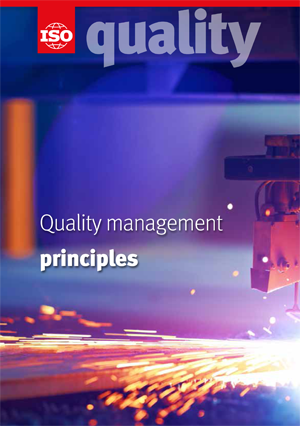ISO Engagement Standards - Part I: Why Now, Research and Potential Implications
Supported by:
- Updated 9001 Quality Management Principles
- QMP 1: Customer Focus
- QMP 2: Leadership
- QMP 3: Engagement of People
- QMP Principle 7: Relationship Management
![]() Click here to download the PDF of this article.
Click here to download the PDF of this article.
This is the first installment of a three-part series on the creation of engagement standards, their evolution, research supporting them and potential implications.
In 2015, the International Organization for Standardization (ISO) issued an update to its widely followed 9001 standards that included the addition of new Quality Management Principles. This document outlines the fundamental conditions necessary for an organization to sustain high levels of quality and performance. While not officially part of the 9001 standards, and general in nature, the report recommends that organizations can benefit by beginning now to find their own tactical strategies for baking these principles into their organization.
In outlining next steps, the report advices: “This document provides a general perspective on the quality management principles underlying ISO’s quality management standards. It gives an overview of these principles and shows how, collectively, they can form a basis for performance improvement and organizational excellence. There are many different ways of applying these quality management principles. The nature of the organization and the specific challenges it faces will determine how to implement them. Many organizations will find it beneficial to set up a quality management system based on these principles.” In other words, ISO says there is no reason for organizations to wait until formal standards are created to start applying these principles.
The report also states that these principles apply to many other standards and will be coordinated to align with management principles used by other ISO certifications.
Now that ISO has approved a formal working group to create formal standards on engagement, the Quality Management Principles provide a clear foundation upon which to create the more granular standards. Anyone familiar with the Enterprise Engagement Alliance’s framework and implementation process for Enterprise Engagement will see a clear overlap related to the focus on engaging all constituents – customers, employees, distribution partners, vendors, communities, etc. – and the need to integrate and align these efforts across the organization. “Having such a clear blueprint from ISO will make the job of creating standards easier,” says Bruce Bolger, EEA founder and project leader for the ISO Working Group on Engagement. “We believe the document provides a very clear roadmap for standards.
 Below is an overview of the Quality Management Principles issued in 2015, four of which specifically involve engagement. Please note that while these principles have been conveyed to ISO 9001 companies, as well as holders of other ISO certifications related to people practices, these are not yet part of the formal certification process for engagement. However, they provide a clear indication of where those guidelines will be focused. The engagement standards will be aimed at helping organizations identify and implement the specific strategies and tactics appropriate to their organizations to build the quality management principles into their culture.
Below is an overview of the Quality Management Principles issued in 2015, four of which specifically involve engagement. Please note that while these principles have been conveyed to ISO 9001 companies, as well as holders of other ISO certifications related to people practices, these are not yet part of the formal certification process for engagement. However, they provide a clear indication of where those guidelines will be focused. The engagement standards will be aimed at helping organizations identify and implement the specific strategies and tactics appropriate to their organizations to build the quality management principles into their culture.
The Quality Management Principles are:
1) Customer focus
2) Leadership
3) Engagement of people
4) Process approach
5) Improvement
6) Evidence-based decision-making
While the principles are focused on process, four are more specifically related to people and engagement: Customer Focus, Leadership, Engagement of People and Relationship Management. Below is a verbatim outline of the new Quality Management Principles that pertain to engagement. For the complete document, click here. This document creates a blueprint for the team involved with creating engagement standards, but also for any organization seeking to bake Enterprise Engagement into their culture starting now.
Editor’s Note: A focus on the link between customer needs and the organization’s mission is a foundational principle of enterprise engagement.
The primary focus of quality management is to meet customer requirements and to strive to exceed customer expectations.
Rationale: Sustained success is achieved when an organization attracts and retains the confidence of customers and other interested parties. Every aspect of customer interaction provides an opportunity to create more value for the customer. Understanding current and future needs of customers and other interested parties contributes to sustained success of the organization.
Key benefits:
- Increased customer value
- Increased customer satisfaction
- Improved customer loyalty
- Enhanced repeat business
- Enhanced reputation of the organization
- Expanded customer base
- Increased revenue and market share.
Actions you can take:
- Recognize direct and indirect customers as those who receive value from the organization.
- Understand customers’ current and future needs and expectations.
- Link the organization’s objectives to customer needs and expectations.
- Communicate customer needs and expectations throughout the organization.
- Plan, design, develop, produce, deliver and support goods and services to meet customer needs and expectations.
- Measure and monitor customer satisfaction and take appropriate actions.
- Determine and take actions on interested parties’ needs and expectations that can affect customer satisfaction.
- Actively manage relationships with customers to achieve sustained success.
Editor’s Note: Leadership is a critical component of the enterprise engagement framework.
Leaders at all levels establish unity of purpose and direction and create conditions in which people are engaged in achieving the organization’s quality objectives.
Rationale: Creation of unity of purpose and direction and engagement of people enable an organization to align its strategies, policies, processes and resources to achieve its objectives.
Key benefits:
- Increased effectiveness and efficiency in meeting the organization’s quality objectives
- Better coordination of the organization’s processes
- Improved communication between levels and functions of the organization
- Development and improvement of the capability of the organization and its people to deliver desired results.
Actions you can take:
Communicate the organization’s mission, vision, strategy, policies and processes throughout the organization.
Create and sustain shared values, fairness and ethical models for behavior at all levels of the organization.
Establish a culture of trust and integrity.
Encourage an organization-wide commitment to quality.
Ensure that leaders at all levels are positive examples to people in the organization.
Provide people with the required resources, training and authority to act with accountability.
Inspire, encourage and recognize people’s contribution.
Editor’s Note: Note that the authors say “people,” not employees. The entire enterprise should be engaged.
Rationale: To manage an organization effectively and efficiently, it is important to involve all people at all levels and to respect them as individuals. Recognition, empowerment and enhancement of competence facilitate the engagement of people in achieving the organization’s quality objectives.
Key benefits:
- Improved understanding of the organization’s quality objectives by people in the organization and increased motivation to achieve them
- Enhanced involvement of people in improvement activities
- Enhanced personal development, initiatives and creativity
- Enhanced people satisfaction
- Enhanced trust and collaboration throughout the organization
- Increased attention to shared values and culture throughout the organization.
Actions you can take:
- Communicate with people to promote understanding of the importance of their individual contribution.
- Promote collaboration throughout the organization.
- Facilitate open discussion and sharing of knowledge and experience.
- Empower people to determine constraints to performance and to take initiative without fear.
- Recognize and acknowledge people’s contribution, learning and improvement.
- Enable self-evaluation of performance against personal objectives.
- Conduct surveys to assess people’s satisfaction, communicate the results and take appropriate actions.
Editor’s Note: This principle aligns with the fundamental proposition of enterprise engagement: Optimal results are achieved when everyone who touches the organization is engaged, including distribution partners, suppliers, communities and shareholders. For sustained success, an organization manages its relationships with interested parties, such as suppliers.
Rationale: Interested parties influence the performance of an organization. Sustained success is more likely to be achieved when the organization manages relationships with all its interested parties to optimize their impact on its performance. Relationship management with its supplier and partner networks is of particular importance.
Key benefits:
- Enhanced performance of the organization and its interested parties through responding to the opportunities and constraints related to each interested party
- Common understanding of goals and values among interested parties
- Increased capability to create value for interested parties by sharing resources and competence and managing quality-related risks
- A well-managed supply chain that provides a stable flow of goods and services
Actions you can take:
- Determine relevant interested parties (such as suppliers, partners, customers, investors, employees and society as a whole) and their relationship with the organization.
- Determine and prioritize interested party relationships that need to be managed.
- Establish relationships that balance short-term gains with long-term considerations.
- Pool and share information, expertise and resources with relevant interested parties.
- Measure performance and provide performance feedback to interested parties, as appropriate, to enhance improvement initiatives.
- Establish collaborative development and improvement activities with suppliers, partners and other interested parties.
- Encourage and recognize improvements and achievements by suppliers and partners.
Editor’s Note: In authorizing the new working group to create engagement standards, ISO recognizes the opportunity to provide organizations greater guidance on the specific tactics of engagement based on the considerable research on the connection between engagement and standards compliance. Part 2 of this series of articles will provide details on that research.
This article is supported by:
For People, Society, and the Future
For information on Canon’s line of inspirational products for rewards, recognition, loyalty programs, and corporate gifts, contact:
Vito Giacalone
Executive, Account - ITC, ITCG Natl Account Camera/Video Division
631.330.8548
















